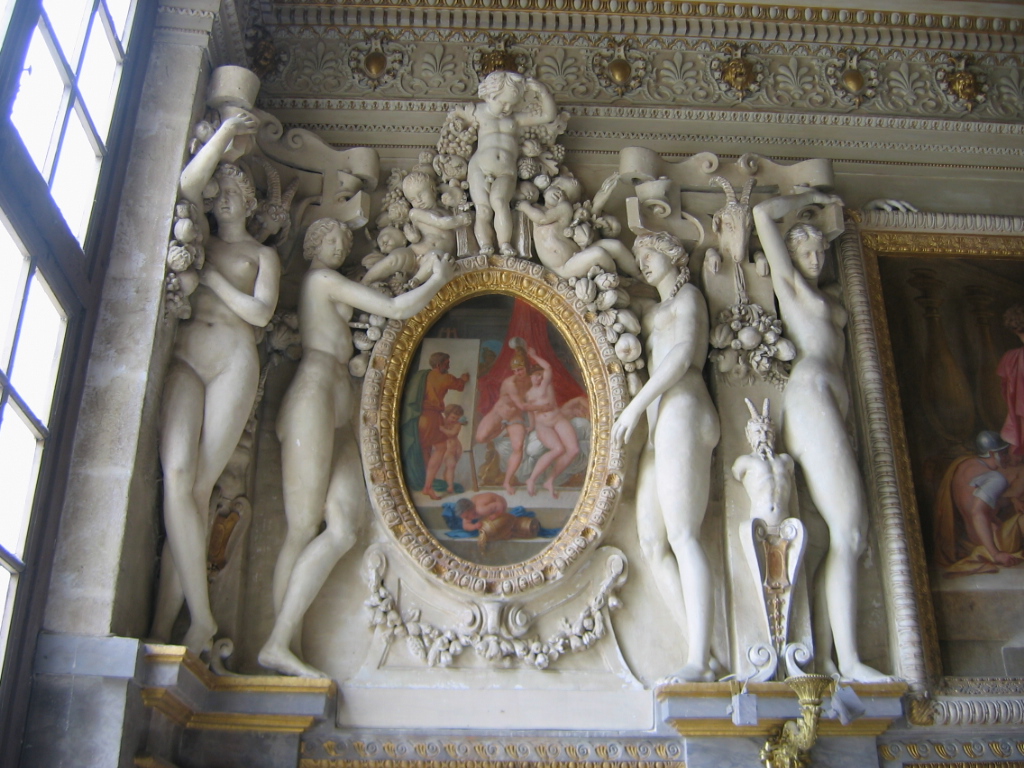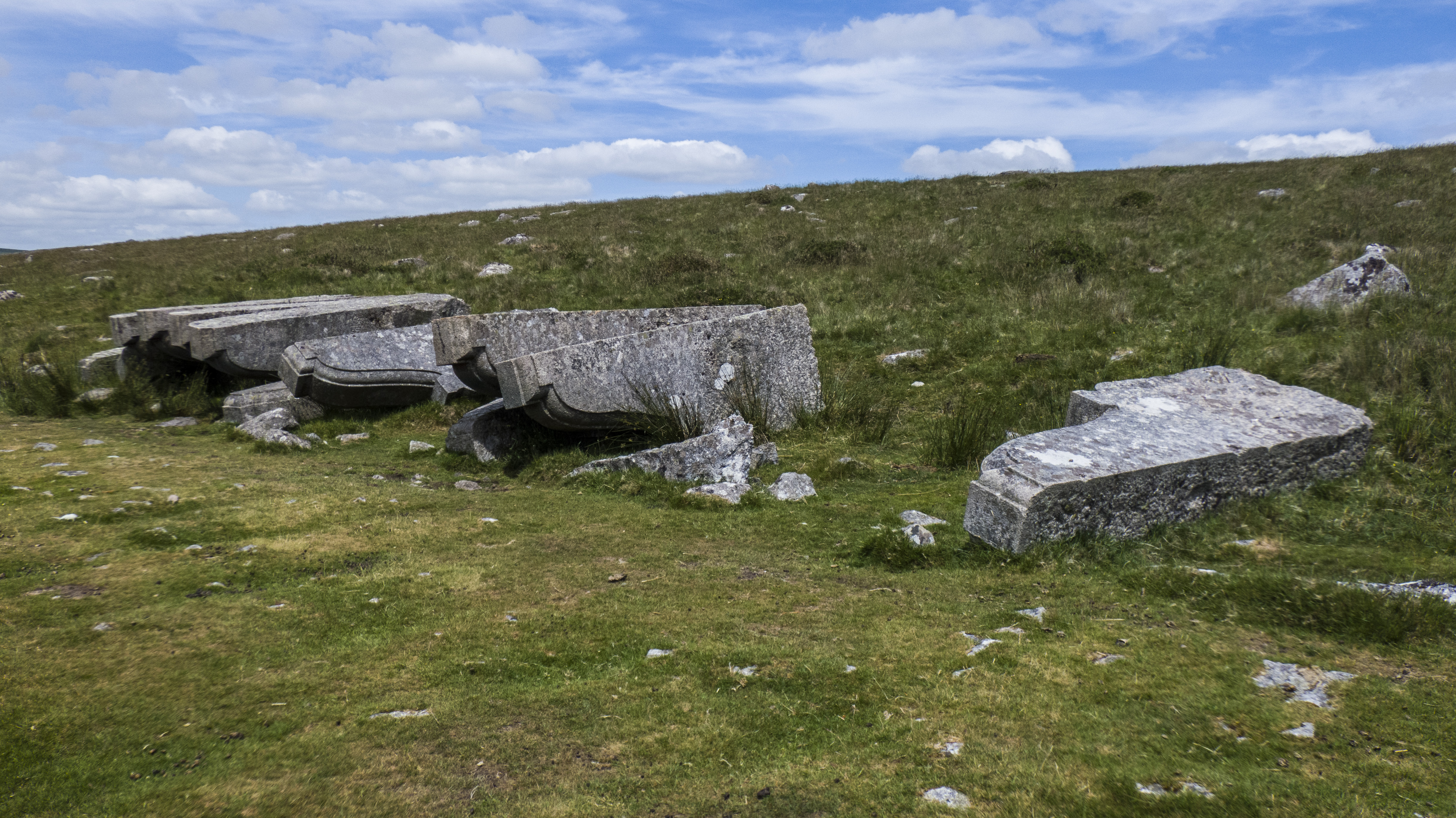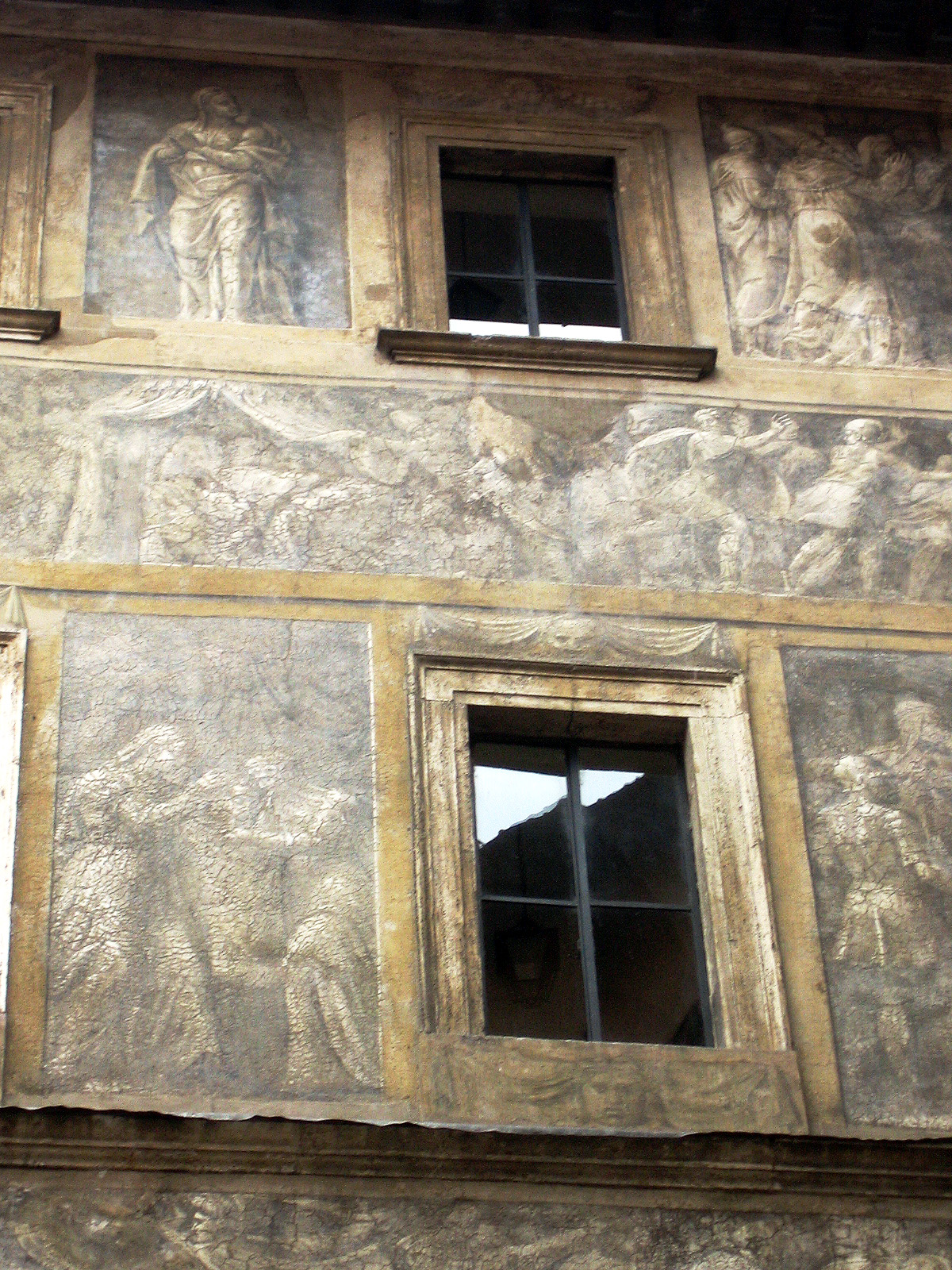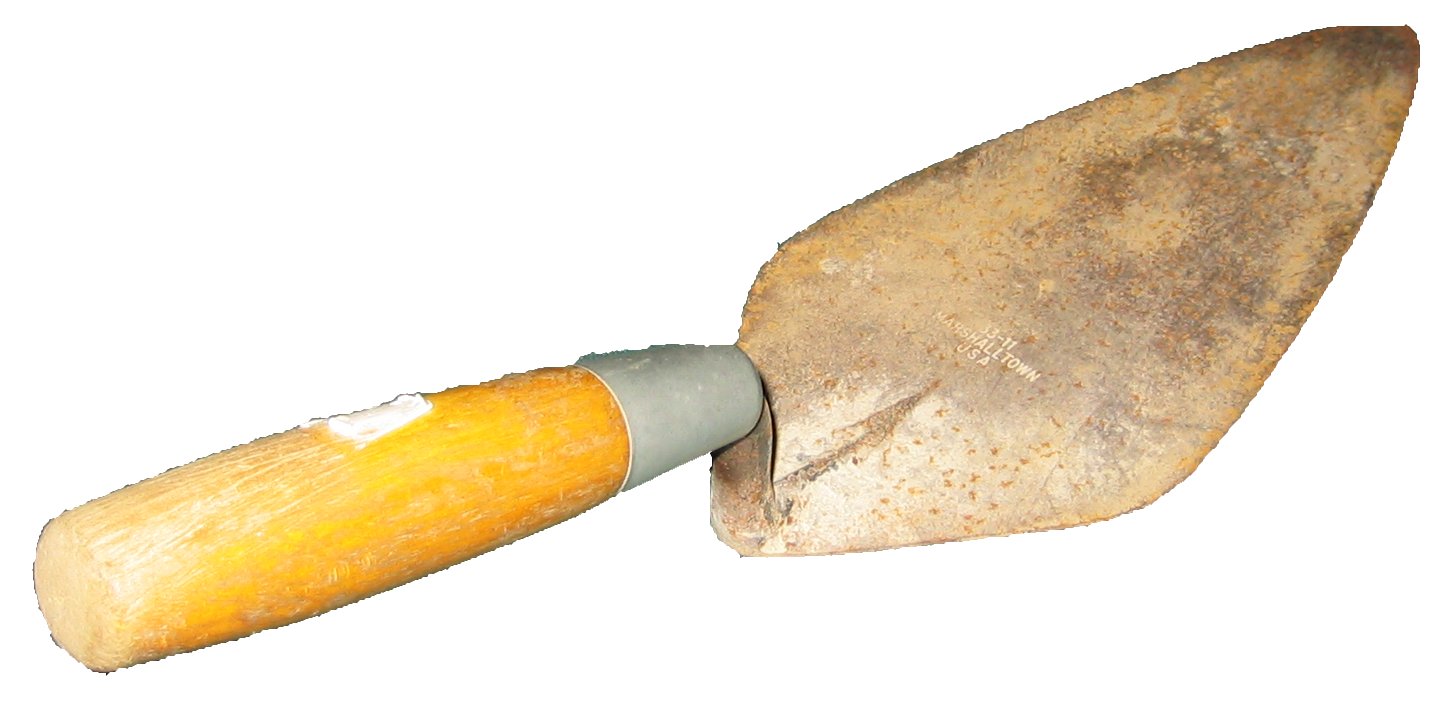|
Lime Plaster
Lime plaster is a type of plaster composed of sand, water, and lime, usually non-hydraulic hydrated lime (also known as slaked lime, high calcium lime or air lime). Ancient lime plaster often contained horse hair for reinforcement and pozzolan additives to reduce the working time. Traditional non-hydraulic hydrated lime only sets through carbonatation when the plaster is kept moist and access of CO2 from the air is possible. It will not set when submersed in water. When a very thick layer or several layers are applied, the lime can remain soft for weeks. The curing time of lime plaster can be shortened by using (natural) hydraulic lime or adding pozzolan additives, transforming it into artificially hydraulic lime. In ancient times, Roman lime plaster incorporated pozzolanic volcanic ash; in modern times, fly ash is preferred. Non-hydraulic lime plaster can also be made to set faster by adding gypsum. Lime production for use in plastering home-made cisterns (in making them im ... [...More Info...] [...Related Items...] OR: [Wikipedia] [Google] [Baidu] |
Plaster - Putz In Pompeji
Plaster is a building material used for the protective or decorative coating of walls and ceilings and for moulding and casting decorative elements. In English, "plaster" usually means a material used for the interiors of buildings, while "render" commonly refers to external applications. The term stucco refers to plasterwork that is worked in some way to produce relief decoration, rather than flat surfaces. The most common types of plaster mainly contain either gypsum, lime, or cement,Franz Wirsching "Calcium Sulfate" in Ullmann's Encyclopedia of Industrial Chemistry, 2012 Wiley-VCH, Weinheim. but all work in a similar way. The plaster is manufactured as a dry powder and is mixed with water to form a stiff but workable paste immediately before it is applied to the surface. The reaction with water liberates heat through crystallization and the hydrated plaster then hardens. Plaster can be relatively easily worked with metal tools and sandpaper and can be moulded, either on s ... [...More Info...] [...Related Items...] OR: [Wikipedia] [Google] [Baidu] |
Diffusion
Diffusion is the net movement of anything (for example, atoms, ions, molecules, energy) generally from a region of higher concentration to a region of lower concentration. Diffusion is driven by a gradient in Gibbs free energy or chemical potential. It is possible to diffuse "uphill" from a region of lower concentration to a region of higher concentration, as in spinodal decomposition. Diffusion is a stochastic process due to the inherent randomness of the diffusing entity and can be used to model many real-life stochastic scenarios. Therefore, diffusion and the corresponding mathematical models are used in several fields beyond physics, such as statistics, probability theory, information theory, neural networks, finance, and marketing. The concept of diffusion is widely used in many fields, including physics (Molecular diffusion, particle diffusion), chemistry, biology, sociology, economics, statistics, data science, and finance (diffusion of people, ideas, data and price v ... [...More Info...] [...Related Items...] OR: [Wikipedia] [Google] [Baidu] |
Calcium Oxide
Calcium oxide (formula: Ca O), commonly known as quicklime or burnt lime, is a widely used chemical compound. It is a white, caustic, alkaline, crystalline solid at room temperature. The broadly used term '' lime'' connotes calcium-containing inorganic compounds, in which carbonates, oxides, and hydroxides of calcium, silicon, magnesium, aluminium, and iron predominate. By contrast, ''quicklime'' specifically applies to the single compound calcium oxide. Calcium oxide that survives processing without reacting in building products, such as cement, is called free lime. Quicklime is relatively inexpensive. Both it and the chemical derivative calcium hydroxide (of which quicklime is the base anhydride) are important commodity chemicals. Preparation Calcium oxide is usually made by the thermal decomposition of materials, such as limestone or seashells, that contain calcium carbonate (CaCO3; mineral calcite) in a lime kiln. This is accomplished by heating the material to above , ... [...More Info...] [...Related Items...] OR: [Wikipedia] [Google] [Baidu] |
Limestone
Limestone is a type of carbonate rock, carbonate sedimentary rock which is the main source of the material Lime (material), lime. It is composed mostly of the minerals calcite and aragonite, which are different Polymorphism (materials science), crystal forms of calcium carbonate . Limestone forms when these minerals Precipitation (chemistry), precipitate out of water containing dissolved calcium. This can take place through both biological and nonbiological processes, though biological processes, such as the accumulation of corals and shells in the sea, have likely been more important for the last 540 million years. Limestone often contains fossils which provide scientists with information on ancient environments and on the evolution of life. About 20% to 25% of sedimentary rock is carbonate rock, and most of this is limestone. The remaining carbonate rock is mostly Dolomite (rock), dolomite, a closely related rock, which contains a high percentage of the mineral Dolomite (mine ... [...More Info...] [...Related Items...] OR: [Wikipedia] [Google] [Baidu] |
Corbel
In architecture, a corbel is a structural piece of stone, wood or metal keyed into and projecting from a wall to carry a wikt:superincumbent, bearing weight, a type of bracket (architecture), bracket. A corbel is a solid piece of material in the wall, whereas a console is a piece applied to the structure. A piece of timber projecting in the same way was called a "tassel" or a "bragger" in England. The technique of corbelling, where rows of corbels deeply keyed inside a wall support a projecting wall or parapet, has been used since Neolithic (New Stone Age) times. It is common in medieval architecture and in the Scottish baronial style as well as in the vocabulary of classical architecture, such as the modillions of a Corinthian order, Corinthian cornice. The corbel arch and corbel vault use the technique systematically to make openings in walls and to form ceilings. These are found in the early architecture of most cultures, from Eurasia to Pre-Columbian architecture. A conso ... [...More Info...] [...Related Items...] OR: [Wikipedia] [Google] [Baidu] |
Column
A column or pillar in architecture and structural engineering is a structural element that transmits, through compression, the weight of the structure above to other structural elements below. In other words, a column is a compression member. The term ''column'' applies especially to a large round support (the shaft of the column) with a capital and a base or pedestal, which is made of stone, or appearing to be so. A small wooden or metal support is typically called a '' post''. Supports with a rectangular or other non-round section are usually called '' piers''. For the purpose of wind or earthquake engineering, columns may be designed to resist lateral forces. Other compression members are often termed "columns" because of the similar stress conditions. Columns are frequently used to support beams or arches on which the upper parts of walls or ceilings rest. In architecture, "column" refers to such a structural element that also has certain proportional and decorative f ... [...More Info...] [...Related Items...] OR: [Wikipedia] [Google] [Baidu] |
Sgraffito
(; ) is an artistic or decorative technique of scratching through a coating on a hard surface to reveal parts of another underlying coating which is in a contrasting colour. It is produced on walls by applying layers of plaster tinted in contrasting colours to a moistened surface, and on pottery by applying two successive layers of contrasting slip (ceramics), slip or glaze to an unfired ceramic body. The Italian past participle is also used for this technique, especially in reference to pottery. Etymology The term is based on the verb 'to scratch', which probably entered Italian through Lombardic language, Lombardic and ultimately traces back to the Greek word 'to write'. The Italian prefix 's-' originates in the Latin prefix 'ex-', and is used in this case to intensify the basic meaning, so that 'to scratch' becomes 'to scratch off'. History Sgraffito on walls has been used in Europe since classical times. It was popularized in Italy in the 15th and 16th centuries a ... [...More Info...] [...Related Items...] OR: [Wikipedia] [Google] [Baidu] |
Scagliola
Scagliola (from the Italian language, Italian ''scaglia'', meaning "chips") is a type of fine plaster used in architecture and sculpture. The same term identifies the technique for producing columns, sculptures, and other architectural elements that resemble inlays in marble. The scagliola technique came into fashion in 17th-century Tuscany as an effective substitute for costly marble inlays, the pietra dura works created for the House of Medici, Medici family in Florence. The use of scagliola declined in the 20th century. Scagliola is a composite substance made from plaster of Paris, glue and natural pigments, imitating marble and other hard stones. The material may be veined with colors and applied to a core, or desired pattern may be carved into a previously prepared scagliola matrix. The pattern's indentations are then filled with the colored, plaster-like scagliola composite, and then polished with flax oil for brightness, and wax for protection. The combination of materials ... [...More Info...] [...Related Items...] OR: [Wikipedia] [Google] [Baidu] |
Marmorino
Marmorino Veneziano is a type of plaster or stucco. It is based on calcium oxide and used for interior and exterior wall decorations. Marmorino plaster can be finished via multiple techniques for a variety of matte, satin, and glossy final effects. It was used as far back as Roman times, but was made popular once more during the Renaissance 500 years ago in Venice. Marmorino is made from crushed marble and lime putty, which can be tinted to give a wide range of colours. This can then be applied to make many textures, from polished marble to natural stone effects. Widely used in Italy, its appeal has spread through North America especially, but now worldwide. Because of the hours of workmanship, the pricing places it in the high-end market. However, many examples can be seen in public buildings, bars, restaurants, etc. Its waterproofing and antibacterial qualities as well as visual effects have also made it very desirable for luxury bathrooms, honeymoon bedrooms and other wet are ... [...More Info...] [...Related Items...] OR: [Wikipedia] [Google] [Baidu] |
Trowel
A trowel is a small hand tool used for digging, applying, smoothing, or moving small amounts of viscous or particulate material. Common varieties include the masonry trowel, garden trowel, and float trowel. A power trowel is a much larger gasoline or electrically powered walk-behind device with rotating paddles used to finish concrete floors. Hand trowel Numerous forms of trowel are used in masonry, concrete, and drywall construction, as well as applying adhesives such as those used in tiling and laying synthetic flooring. Masonry trowels are traditionally made of forged carbon steel, but some newer versions are made of cast stainless steel, which has longer wear and is rust-free. These include: *Bricklayer's trowel has an elongated triangular-shaped flat metal blade, used by stonemason, masons for leveling, spreading, and shaping cement, plaster, and mortar (masonry), mortar. *Pointing trowel, a scaled-down version of a bricklayer's trowel, for small jobs and repair wo ... [...More Info...] [...Related Items...] OR: [Wikipedia] [Google] [Baidu] |
Spatula
A spatula is a broad, flat, flexible blade used to mix, spread and lift material including foods, drugs, plaster and paints. In medical applications, "spatula" may also be used synonymously with tongue depressor. The word ''spatula'' derives from the Latin word for a flat piece of wood or splint, a diminutive form of the Latin , meaning 'broadsword', and hence can also refer to a tongue depressor. The words '' spade'' (digging tool) and '' spathe'' are similarly derived. The word ''spatula'' has been used in English since 1525. Use Spatulas are usually used to scrape within the contours of a mixing bowl or to level off the top of a dry mixing cup. Kitchen use American English In American English, ''spatula'' refers broadly to a number of broad, flat utensils. The word commonly refers to a turner or flipper (known in British English as a '' fish slice''), used to lift and flip food items during cooking, such as pancakes and fillets. The blades on these are usually made o ... [...More Info...] [...Related Items...] OR: [Wikipedia] [Google] [Baidu] |
Ben-Zvi Institute
Yad Ben Zvi (), also known as the Ben-Zvi Institute, is a research institute and publishing house named for Israeli president Yitzhak Ben-Zvi in Jerusalem. History and activities Yad Ben-Zvi is a research institute established to continue the Zionist, educational and cultural activities of Israel's second and longest-serving president, Yizhak Ben–Zvi. It is housed in the home and offices of Ben-Zvi and his wife, Rachel Yanait, in Jerusalem's Rehavia neighborhood. Ben-Zvi founded the institute in 1947 to explore the history and culture of the Jewish communities living in Arab countries. It houses a library of manuscripts, rare books and a photographic archive, and runs an academic publishing house.A national institution Gail Lichtman for |






